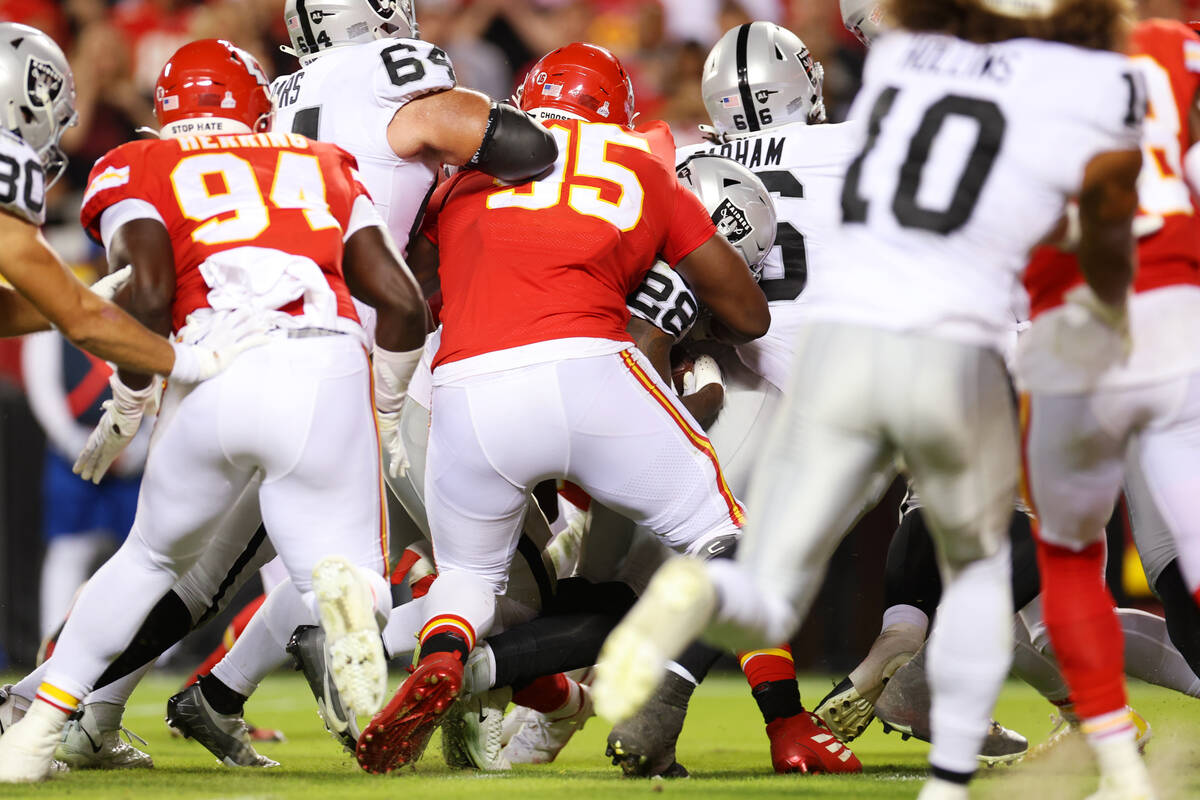Gut feeling, not analytics, guided Raiders’ 2-point decision
There was an egregious coaching decision made in the final minutes of the Raiders’ 30-29 loss to the Chiefs on Monday night at Arrowhead Stadium in Kansas City, Mo.
But it wasn’t made by Josh McDaniels.
Kansas City coach Andy Reid opted to punt the ball on a fourth-and-3 from the Raiders’ 46-yard line with 2:36 remaining rather than go for a first down.
That decision dropped the Chiefs’ win probability from 72 percent to 66 percent. The Raiders nearly made Reid pay for the choice only to have their potential game-winning drive fall short of field goal-range.
“This should be framed a lot differently than the Josh McDaniels decision,” said Kevin Cole, a data scientist from Pro Football Focus said of Reid’s choice to punt in that situation.
Yet much of the attention in the aftermath of the Chiefs’ victory has been on McDaniels’ opting to go for a 2-point conversion and the lead when the Raiders scored a touchdown to get within one point with 4:27 to play.
Critics of the analytics revolution shouted from the rooftops, or in this case, posted in all caps on their Twitter accounts, about how math nerds have ruined the game they once loved.
But the truth is that most analytic models didn’t recommend McDaniels going for two in that situation.
Data and analytics expert Ben Baldwin said his model had a very slight lean on kicking the extra point being the most optimal choice for the Raiders in that situation.
Other models were also very close to a toss-up, with some very slightly favoring going for the 2-point conversion.
“Both of those two-point conversion decisions were coin flips at best,” Cole said of the Raiders and Chiefs both going for two after fourth-quarter touchdowns.
Analytics models are best used when the choice is very clear. The best of them take into specific game factors that are incredibly difficult to analyze in real time when a coach has literally seconds to make a decision. The models assist in decision-making that optimizes, not guarantees, a team’s chances to win the game.
The human element of coaching, such as feel and experience, is what comes into play when the numbers don’t make the decision obvious.
“There’s no way your numbers could have told the Raiders this was a must-go for 2 situation,” Cole said on his podcast. “Those numbers just do not exist.
“This is McDaniels making a decision on what his vibes are, what he believes and whether he wants to put the team in that situation or not.”
McDaniels said as much on Monday night after the game when he explained he believed the Raiders had a very good play that they liked in the situation. Running back Josh Jacobs came up just short of the goal line on the play and kept Kansas City in the lead.
“We are certainly aware of the analytical portion of the data that’s available to us,” McDaniels said Tuesday. “I think at some point your feel for the game is not unimportant.”
So on Monday, having had a day to reflect, McDaniels said his decision to go for two, “like I said, during the course of the game I felt like that was the right thing to do.”
Here’s the crazy thing: Even though the Raiders went on to lose, the decision actually worked.
Most likely because they had the lead, Reid and the Chiefs got very conservative on the ensuing drive with swing passes and running plays instead of turning Patrick Mahomes loose like they may have in a tie game or had they been behind.
Then Reid decided to punt, which he certainly wouldn’t have done had they not been ahead in the game.
So the Raiders had the ball with a timeout before the two-minute warning with a chance to win the game in regulation with a field goal. It was essentially a better scenario than they ever could have asked for had the game gone to overtime.
The drive fell short, but the Raiders had the game in their hands.
Contact Adam Hill at ahill@reviewjournal.com. Follow @AdamHillLVRJ on Twitter.
Raiders bring back popular receiver
Tyron Johnson is back.
The wide receiver who quickly became a fan favorite this offseason with his speed and big-play ability was brought back to the practice squad just days after the team placed him on waivers.
Veteran wide receiver Albert Wilson, who was added to the practice squad last week, has been promoted to the active roster. The Raiders also released defensive back Darren Evans from the practice squad and filled the remaining practice squad roster spot with cornerback Tyler Hall.
Johnson saw just four offensive snaps through four games and was released on Friday.























